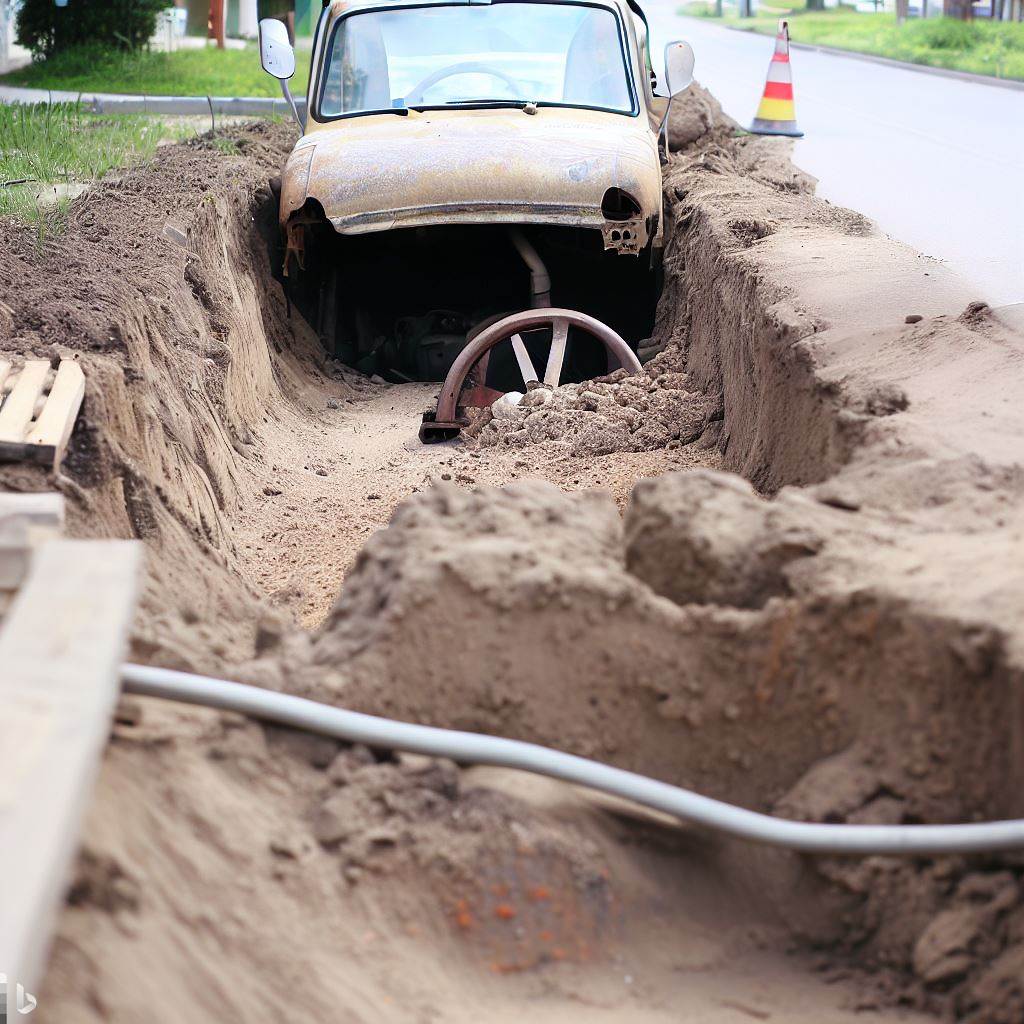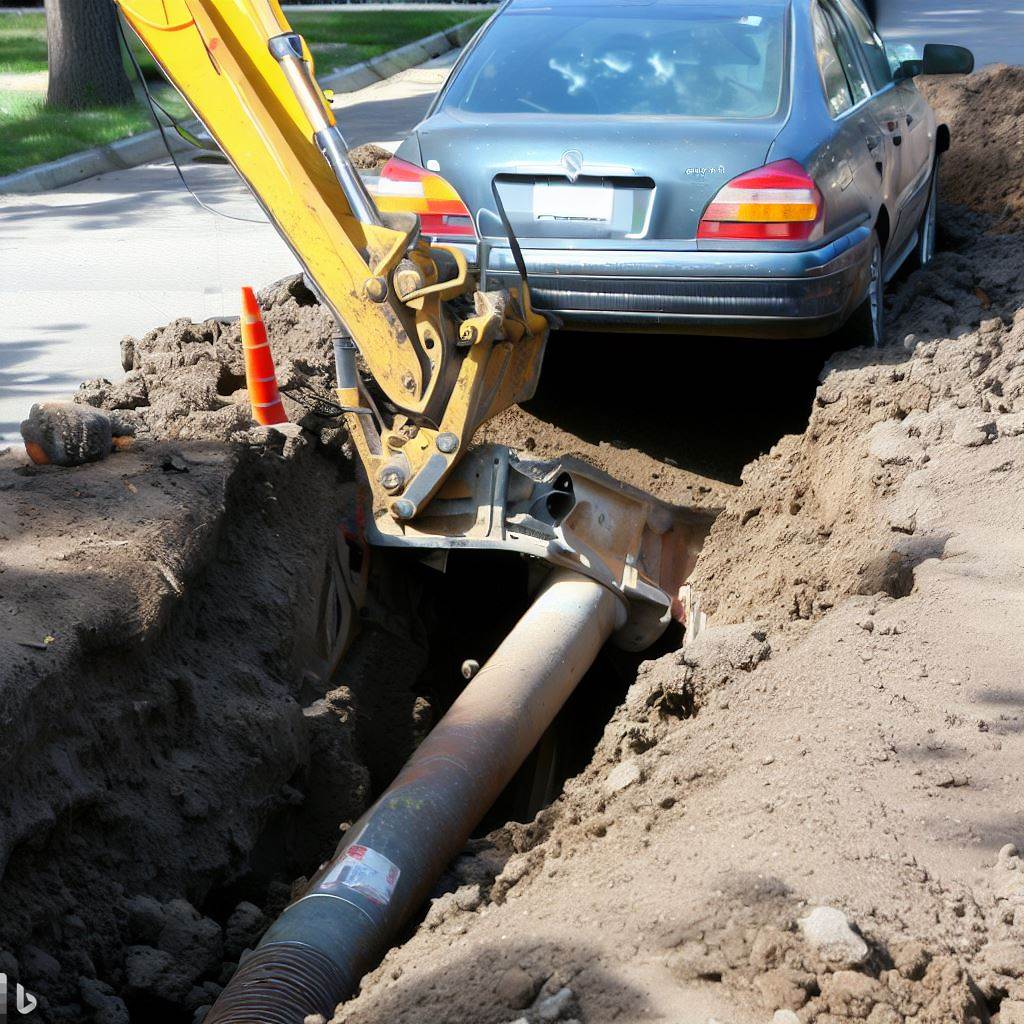Today we’re hitting the road—literally—and navigating around the enigma: is it safe to drive over buried gas lines? Let’s find out together if our everyday routines are causing us to unintentionally live on the edge.
Let’s admit it, we’ve all nervously eyed that “Gas Line – Do Not Dig!” sign and wondered how dangerous it could be. Could you accidentally spark a suburban explosion just by driving over your lawn?
Sounds like the basis for an action movie; every time I park my car, I’m playing out a scene straight from ‘Fast and Furious’. Hold the suspense though! We’re here to debunk this myth. This post has got answers that should quell those fears. So buckle up!
Here is an exciting article you might be interested in is masonry sand the same as play sand
Another article for you is moss between pavers bad

Safety Measures when Driving over Buried Gas Lines
When it comes to driving over buried gas lines, safety should always be your top priority. Understanding the potential risks and taking necessary precautions can help prevent accidents and protect both yourself and the surrounding infrastructure.
Let’s delve into some important safety measures you need to keep in mind.
Identifying the Presence of Buried Gas Lines
Before you start driving, it is essential to identify the presence of any buried gas lines in your vicinity.
This can be done by contacting your local utility company or employing professional utility locating services.
They will use advanced detection tools such as ground-penetrating radar and electromagnetic equipment to accurately locate underground pipes, including gas lines.
Effects of Vehicle Weight on Buried Gas Lines
The weight of vehicles has a significant impact on buried gas lines’ integrity.
Heavy vehicles exert greater pressure on the ground, which can potentially damage or rupture these underground pipelines if driven over them carelessly.
Therefore, it is crucial to consider the weight of your vehicle before deciding whether it is safe to drive over a particular area with buried gas lines.
Permissible and Non-permissible Vehicles Over Gas Lines
Not all vehicles are suitable for driving over buried gas lines without causing any harm. It is essential to know which types of vehicles are considered permissible in these situations.
Lighter vehicles like cars pose less risk compared to heavy trucks or machinery that have higher weights concentrated on smaller contact areas.
Always consult with professionals who specialize in underground pipe networks before attempting such maneuvers.
Proper Precautions for Heavy Machinery Operation near Gas Line Territory
In construction sites where heavy machinery operates near gas line territories, extra caution must be exercised. Here are some crucial precautions to follow:
1. Implement Clear Signage and Warning Systems
Clearly mark the boundaries of gas line territories with visible signage and warning systems.
This will help equipment operators to identify areas where they should exercise extra care and avoid driving or operating machinery over buried gas lines.
2. Training and Certification for Equipment Operators
Ensure that all equipment operators have received proper training and certification in safely working around underground utilities, including gas lines.
They should be aware of the potential risks associated with driving heavy machinery over these pipelines and understand how to minimize those risks.
3. Damage Risks to Underlying Infrastructure from Above Ground Activity
While it is important to focus on the impact of vehicles on buried gas lines, we must also consider other above-ground activities that can pose a risk to their integrity.
Construction work, excavation projects, or even simply parking heavy objects above underground pipelines can potentially cause damage.
Therefore, always exercise caution when engaging in any kind of activity near these sensitive infrastructures.
Legal and Regulatory Considerations for Building or Driving Over Underground Pipelines
Driving or building structures over underground pipelines requires compliance with legal regulations set by authorities concerned with public safety. Here are some important considerations:
1. Obtain Necessary Permits Before Commencing Construction Work
Before embarking on construction projects involving driving piles into the ground or erecting structures above buried gas lines, make sure you obtain all necessary permits from relevant authorities who oversee pipeline safety regulations in your area.
2. Adhere to Safety Codes During Construction Activities
Strictly adhere to safety codes provided by regulatory bodies while performing construction activities near underground pipelines.
These codes typically include guidelines on minimum clearance distances between pipelines and structures as well as safe procedures for excavating soil around them.
Efforts Towards Reducing Harmful Interaction Between Vehicles and Piped Networks
Recognizing the potential risks associated with driving over buried gas lines, several measures have been implemented to minimize harmful interactions between vehicles and underground pipelines. Some of these efforts include:
1. Creating Dedicated Crossings for Vehicles
In areas where vehicular traffic is common near underground pipelines, dedicated crossings are constructed to provide a safe pathway.
These crossings are designed with reinforced materials that can withstand heavy vehicle loads without jeopardizing the integrity of the buried gas lines.
2. Installing Protective Covers or Sleeves
To add an additional layer of protection, protective covers or sleeves made from durable materials may be installed around buried gas lines in high-risk zones such as roadways or construction sites.
These covers act as a shield against accidental impact or damage caused by vehicles driving over them.

Emergency Response Handling in Case of Damage to a Buried Gas Line
Despite all safety precautions, accidents can still occur, resulting in damage to buried gas lines. In such cases, it is crucial to know how to respond promptly and effectively:
1. Evacuate the Area Immediately
If you accidentally cause damage to a buried gas line while driving or during any other activity, evacuate the area immediately and move to a safe distance away from possible leaks or explosions.
2. Contact Emergency Services and Utility Company
Notify emergency services about the situation right away so they can assess the risk level accurately and take appropriate actions if necessary.
Simultaneously contact your local utility company’s emergency helpline so they can dispatch their trained personnel quickly for repairs.
Conclusion
When it comes to driving over buried gas lines, prioritizing safety is paramount. By identifying their presence beforehand and taking necessary precautions based on vehicle weight and type, you can significantly reduce the risks of damage.
Also, adhering to legal regulations, implementing safety measures during construction activities, and being aware of emergency response protocols further enhance the overall safety of interacting with buried gas lines.
Remember, cautious driving and responsible behavior can go a long way in safeguarding underground infrastructure and ensuring the well-being of everyone involved.
If you found this article exciting, here is another great read: is sand an insulator
We also found this great pick for you: japanese snails for ponds
FAQs
Q: Is it safe to drive over buried gas lines?
A: It is generally not safe to drive over buried gas lines. Gas lines are an important part of the infrastructure that delivers natural gas to homes and businesses. If a gas line is damaged or ruptured, it can cause a serious safety hazard, including the risk of fire or explosion.
Q: How deep are gas lines buried?
A: Gas lines are typically buried at a depth of at least 12 inches underground. This depth ensures that the lines are well-protected and reduces the risk of accidental damage.
Q: Can I safely dig near gas lines?
A: It is strongly advised not to dig near gas lines unless absolutely necessary. If you need to dig near a gas line, it is important to contact your local gas company and request them to mark the location of the lines before you start digging. This will help ensure your safety and prevent any potential damage.
Q: What should I do if a gas line is exposed?
A: If you accidentally expose a gas line while digging, you should immediately stop digging, evacuate the area, and call your local gas company to report the situation. Do not attempt to fix or cover the exposed gas line yourself – leave it to the professionals.
Q: Can I drive over a gas line that is buried deeper than 12 inches?
A: While driving over a gas line that is buried deeper than 12 inches is generally safer, it is still not recommended. It is always best to avoid driving over any underground utility lines to minimize the risk of damage.
Q: What should I do if I smell gas in the air?
A: If you smell gas in the air, it is important to take immediate action. Leave the area immediately, avoid using any electrical switches or devices, and call your local gas company to report the gas odor. They will send a technician to assess the situation and take appropriate actions.
Q: Are gas lines always marked?
A: Gas lines are not always marked, especially on private property. However, if you plan to dig on your property, it is recommended to contact your local gas company and request them to mark the location of the gas lines to ensure your safety.
Q: Can I plant trees or shrubs over gas lines?
A: Planting trees or shrubs directly over gas lines is not recommended. The roots from these plants can potentially damage the gas lines, leading to leaks or other issues. It is important to have a clear understanding of the location of gas lines on your property before planting anything.
Q: What should I do if I accidentally damage a gas line?
A: If you accidentally damage a gas line, such as hitting it with a shovel or construction equipment, you should immediately cease all activities, evacuate the area, and call 811 or your local gas company to report the incident. They will send a professional to assess the situation and make the necessary repairs.
Q: Can I be fined for damaging a gas line?
A: Damaging a gas line can have serious consequences, and you may be subject to fines or other penalties depending on the jurisdiction. It is important to always exercise caution and follow proper procedures when working near gas lines to avoid any potential fines or legal issues.
